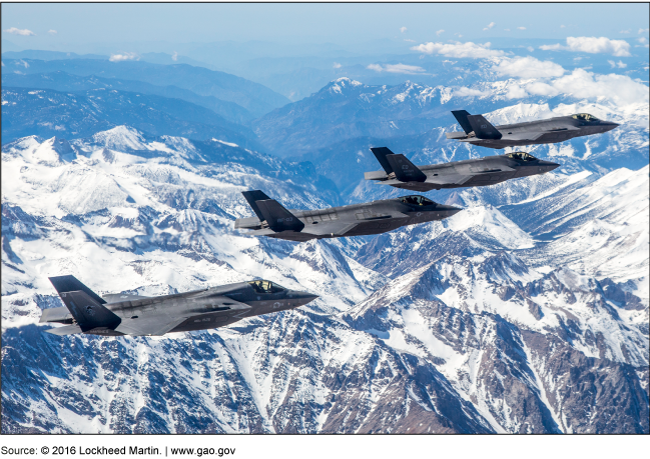Defense Acquisitions: Observations on the F-35 and Air Force's Advanced Battle Management System
Fast Facts
This testimony provides updates on 2 acquisitions: the F-35 fighter aircraft and the Advanced Battle Management System (ABMS), which is intended to replace the systems that currently track air, land, and sea targets.
The F-35 program is embarking on a $10.5 billion modernization effort through FY 2024 to meet evolving threats. We found that the program needs to complete its business case—the program’s estimated cost and proposed schedule—before beginning. The aircraft also has yet to meet half of its reliability and maintainability goals.
The Air Force is still determining the exact capabilities it would like ABMS to provide.
F-35 Joint Strike Fighters

Photo of Joint Strike Fighters in flight
Highlights
What GAO Found
The Department of Defense (DOD) wrapped up the F-35 development program in April 2018 and expects to complete operational testing in December 2019. DOD has turned its attention to modernization efforts—referred to as Block 4—to add new capabilities to address evolving threats. The program office estimates Block 4 to cost at least $10.5 billion through 2024. DOD plans to start Block 4 development without a complete business case identifying baseline cost and schedule estimates. Key documents for establishing a business case, such as an independent cost estimate, will not be ready before the program plans to award Block 4 development contracts in May 2019 (see figure).
Three F-35 Modernization Business Case Documents That Will Not Be Ready Before the Planned Development Contract Awards

Without a business case—consistent with acquisition best practices—program officials cannot be confident that the risk of committing to development has been reduced adequately prior to planned contract awards.
The program made slow, sustained progress in improving the F-35's reliability and maintainability (R&M). F-35 aircraft are assessed against eight R&M metrics, which inform how much time the aircraft will be in maintenance rather than operations. Half of these metrics are not meeting targets. While the program office has a plan for improving R&M, its guidance is not in line with GAO's acquisition best practices or internal control standards as it does not include specific, measurable objectives, align improvement projects to meet those objectives, and prioritize funding to match resources to R&M requirements. If the R&M requirements are not met, the warfighter will have to settle for a less reliable and more costly aircraft than originally planned. This contributes to the F-35's $1.12 trillion estimated sustainment costs and challenges with maintaining an expanding fleet that also has supply chain and logistics system problems.
GAO's ongoing work indicates that the Air Force's Advanced Battle Management System (ABMS)—intended to provide battle management command and control and surveillance across air, land, and sea—is in the early stages of planning. The capabilities and the strategy to deliver those capabilities are still to be determined. The Air Force plans to manage ABMS as a family of systems, integrating sensors from existing and future weapons programs, and overseen by a Chief Architect—whose role is still to be determined. The Air Force expects to further define ABMS after analyzing different options for delivering the capability. That analysis is expected to be complete in summer 2019.
Why GAO Did This Study
In 2018, the F-35 program began operational testing. Also in 2018, the Air Force continued planning for the acquisition of ABMS, intended to modernize how DOD maintains command and control over and manages the future battlefield. Both the F-35 and ABMS are expected to play key roles in DOD's modernization efforts.
This testimony statement discusses (1) the F-35 program's development and modernization efforts, and progress in improving the aircraft's R&M and (2) DOD's current planning efforts for ABMS. This statement is based on two GAO reports on the F-35 published in April 2019 and on GAO's ongoing work examining ABMS. To conduct this work, GAO analyzed DOD management reports; discussed the efforts with program and contractor officials; and compared both efforts to DOD policy and GAO acquisition best practices.
Recommendations
In April 2019, GAO recommended that the F-35 program office complete its Block 4 business case before making more contract awards. DOD did not concur, citing that it has adequate knowledge to begin Block 4 development. GAO maintains that completing its business case before awarding its Block 4 development contracts would put DOD and the program in a better position to successfully develop Block 4 capabilities. GAO also recommended that DOD take action to improve its R&M performance. DOD concurred and noted the actions it would take.
